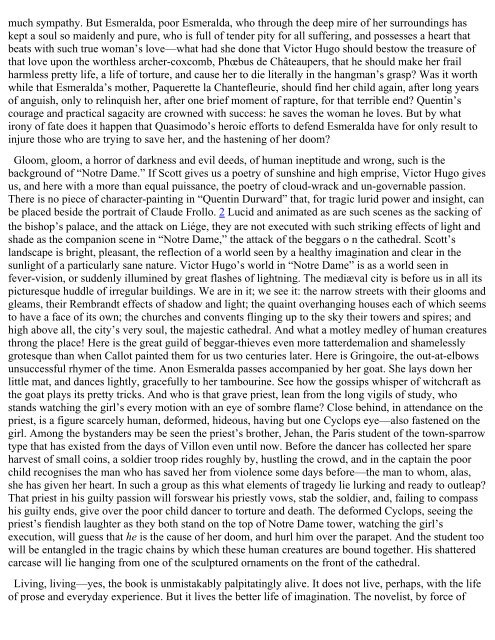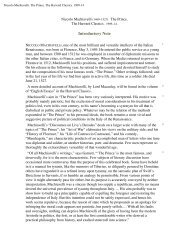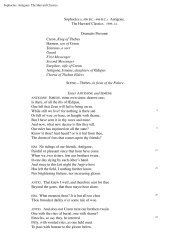Notre Dame de Paris - Bartleby.com
Notre Dame de Paris - Bartleby.com
Notre Dame de Paris - Bartleby.com
Create successful ePaper yourself
Turn your PDF publications into a flip-book with our unique Google optimized e-Paper software.
much sympathy. But Esmeralda, poor Esmeralda, who through the <strong>de</strong>ep mire of her surroundings has<br />
kept a soul so mai<strong>de</strong>nly and pure, who is full of ten<strong>de</strong>r pity for all suffering, and possesses a heart that<br />
beats with such true woman’s love—what had she done that Victor Hugo should bestow the treasure of<br />
that love upon the worthless archer-cox<strong>com</strong>b, Phœbus <strong>de</strong> Châteaupers, that he should make her frail<br />
harmless pretty life, a life of torture, and cause her to die literally in the hangman’s grasp? Was it worth<br />
while that Esmeralda’s mother, Paquerette la Chantefleurie, should find her child again, after long years<br />
of anguish, only to relinquish her, after one brief moment of rapture, for that terrible end? Quentin’s<br />
courage and practical sagacity are crowned with success: he saves the woman he loves. But by what<br />
irony of fate does it happen that Quasimodo’s heroic efforts to <strong>de</strong>fend Esmeralda have for only result to<br />
injure those who are trying to save her, and the hastening of her doom?<br />
Gloom, gloom, a horror of darkness and evil <strong>de</strong>eds, of human ineptitu<strong>de</strong> and wrong, such is the<br />
background of “<strong>Notre</strong> <strong>Dame</strong>.” If Scott gives us a poetry of sunshine and high emprise, Victor Hugo gives<br />
us, and here with a more than equal puissance, the poetry of cloud-wrack and un-governable passion.<br />
There is no piece of character-painting in “Quentin Durward” that, for tragic lurid power and insight, can<br />
be placed besi<strong>de</strong> the portrait of Clau<strong>de</strong> Frollo. 2 Lucid and animated as are such scenes as the sacking of<br />
the bishop’s palace, and the attack on Liége, they are not executed with such striking effects of light and<br />
sha<strong>de</strong> as the <strong>com</strong>panion scene in “<strong>Notre</strong> <strong>Dame</strong>,” the attack of the beggars o n the cathedral. Scott’s<br />
landscape is bright, pleasant, the reflection of a world seen by a healthy imagination and clear in the<br />
sunlight of a particularly sane nature. Victor Hugo’s world in “<strong>Notre</strong> <strong>Dame</strong>” is as a world seen in<br />
fever-vision, or sud<strong>de</strong>nly illumined by great flashes of lightning. The mediæval city is before us in all its<br />
picturesque huddle of irregular buildings. We are in it; we see it: the narrow streets with their glooms and<br />
gleams, their Rembrandt effects of shadow and light; the quaint overhanging houses each of which seems<br />
to have a face of its own; the churches and convents flinging up to the sky their towers and spires; and<br />
high above all, the city’s very soul, the majestic cathedral. And what a motley medley of human creatures<br />
throng the place! Here is the great guild of beggar-thieves even more tatter<strong>de</strong>malion and shamelessly<br />
grotesque than when Callot painted them for us two centuries later. Here is Gringoire, the out-at-elbows<br />
unsuccessful rhymer of the time. Anon Esmeralda passes ac<strong>com</strong>panied by her goat. She lays down her<br />
little mat, and dances lightly, gracefully to her tambourine. See how the gossips whisper of witchcraft as<br />
the goat plays its pretty tricks. And who is that grave priest, lean from the long vigils of study, who<br />
stands watching the girl’s every motion with an eye of sombre flame? Close behind, in attendance on the<br />
priest, is a figure scarcely human, <strong>de</strong>formed, hi<strong>de</strong>ous, having but one Cyclops eye—also fastened on the<br />
girl. Among the bystan<strong>de</strong>rs may be seen the priest’s brother, Jehan, the <strong>Paris</strong> stu<strong>de</strong>nt of the town-sparrow<br />
type that has existed from the days of Villon even until now. Before the dancer has collected her spare<br />
harvest of small coins, a soldier troop ri<strong>de</strong>s roughly by, hustling the crowd, and in the captain the poor<br />
child recognises the man who has saved her from violence some days before—the man to whom, alas,<br />
she has given her heart. In such a group as this what elements of tragedy lie lurking and ready to outleap?<br />
That priest in his guilty passion will forswear his priestly vows, stab the soldier, and, failing to <strong>com</strong>pass<br />
his guilty ends, give over the poor child dancer to torture and <strong>de</strong>ath. The <strong>de</strong>formed Cyclops, seeing the<br />
priest’s fiendish laughter as they both stand on the top of <strong>Notre</strong> <strong>Dame</strong> tower, watching the girl’s<br />
execution, will guess that he is the cause of her doom, and hurl him over the parapet. And the stu<strong>de</strong>nt too<br />
will be entangled in the tragic chains by which these human creatures are bound together. His shattered<br />
carcase will lie hanging from one of the sculptured ornaments on the front of the cathedral.<br />
Living, living—yes, the book is unmistakably palpitatingly alive. It does not live, perhaps, with the life<br />
of prose and everyday experience. But it lives the better life of imagination. The novelist, by force of










